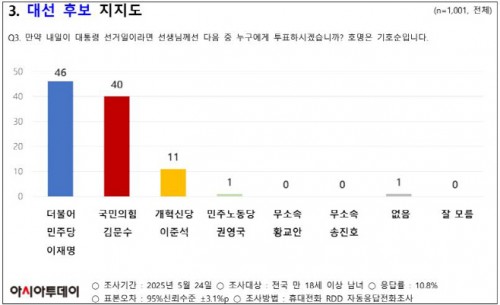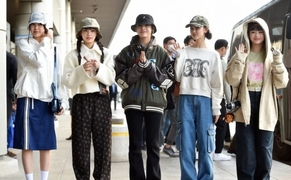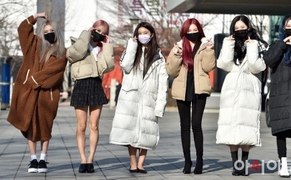 |
With just nine days remaining until the June 3 presidential election, Democratic Party of Korea (DPK) candidate Lee Jae-myung is maintaining a 6 percentage point lead over People Power Party (PPP) candidate Kim Moon-soo, according to a new public opinion survey. The poll, conducted by the Korea Opinion Public Research Association (KOPRA) on May 24 and commissioned by Asia Today, shows Lee with 46% support, Kim with 40%, and New Reform Party candidate Lee Jun-seok with 11%. Other candidates, including Kwon Young-guk of the Democratic Labor Party and independents Hwang Kyo-ahn and Song Jin-ho, received 1% or less.
This result marks little change from KOPRA’s previous poll conducted on May 20, in which Lee also had 46%, Kim 41%, and Lee Jun-seok 10%. The near-identical figures suggest that the second televised debate held on May 23 had minimal effect on voter sentiment.
The poll also revealed detailed trends by age group. Lee garnered the most support among voters in their 40s and 50s, with 58% and 61% respectively. He also led among those in their 60s with 51%. Kim Moon-soo, on the other hand, performed strongest among voters in their 30s (44%) and those aged 70 or older (59%).
By age brackets, support for Lee stood at 34% among voters aged 18 to 29, 31% among those in their 30s, 58% among those in their 40s, 61% in their 50s, 51% in their 60s, and 36% among those 70 and older. Kim received 25%, 44%, 35%, 33%, 44%, and 59% respectively among those same age groups.
In terms of gender, Lee was supported by 45% of male respondents and 48% of female respondents. Kim’s support among men stood at 36%, while 44% of women indicated support for him.
Regionally, Lee led in traditional strongholds such as Gwangju and the Jeolla provinces with 72% support. He also led in Seoul (43%), Incheon and Gyeonggi (44%), Daejeon/Sejong/Chungcheong (42%), Busan/Ulsan/Gyeongnam (44%), and Gangwon/Jeju (55%). Kim led in Daegu and Gyeongbuk with 53% support and slightly outperformed Lee in Busan/Ulsan/Gyeongnam with 46%.
Kim’s support by region came in at 40% in Seoul, 38% in Incheon and Gyeonggi, 45% in the Daejeon/Sejong/Chungcheong region, 12% in Gwangju and Jeolla, 53% in Daegu/Gyeongbuk, 46% in Busan/Ulsan/Gyeongnam, and 40% in Gangwon/Jeju.
Among ideological groups, Lee dominated the progressive base with 80% support, unchanged from the previous poll. Among conservatives, Kim’s support dropped to 64%, down 8 points from 72%. Among moderate voters, Lee led with 44%, compared to Kim’s 39%, narrowing the gap by one point since the previous poll.
When broken down by party affiliation, Lee was supported by 95% of Democratic Party supporters, 75% of Rebuilding Korea Party supporters, and 8% of New Reform Party supporters. Even among voters who were unaffiliated or undecided, Lee received 22% support. Kim was supported by 89% of PPP supporters, 13% of Rebuilding Korea Party supporters, and 21% of New Reform Party supporters. Among undecided voters, Kim received 55%.
By ideological self-identification, 21% of conservatives backed Lee, while 64% backed Kim. Among moderates, 44% supported Lee and 39% supported Kim. Among progressives, Lee held 80% support compared to Kim’s 12%. Among voters who responded “don’t know,” Kim held a slight lead with 42% to Lee’s 33%.
Overall, the data suggests that Lee Jae-myung has achieved stronger consolidation of his support base, especially among moderates and progressives. In contrast, Kim Moon-soo has yet to fully consolidate conservative support, with signs of stagnation in his approval ratings.
The poll was conducted using automated response systems (ARS) via wireless random digit dialing (RDD). Of 9,229 calls placed, 1,001 responses were collected, yielding a response rate of 10.8%. The results were weighted by gender, age, and region based on April 2025 Ministry of Interior and Safety population data. The poll has a margin of error of ±3.1 percentage points at a 95% confidence level. Further details are available on the website of the National Election Survey Deliberation Commission.
Most Read
-
1
-
2
-
3
-
4
-
5
-
6
-
7





















